Archive for March, 2023

Universe Sandbox Roadmap: 2023 & Beyond
Mar 31st
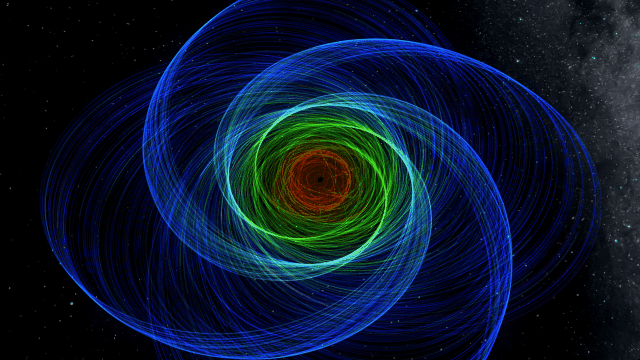
We’re working to give you more power to understand and control the complex phenomena of the universe. Our roadmap for 2023 includes simulating the lakes of liquid methane on Titan, hot planets emitting light, and realistically colliding spacecraft and bananas. But before we dive in, let’s recap some accomplishments from last year.
Highlights From 2022
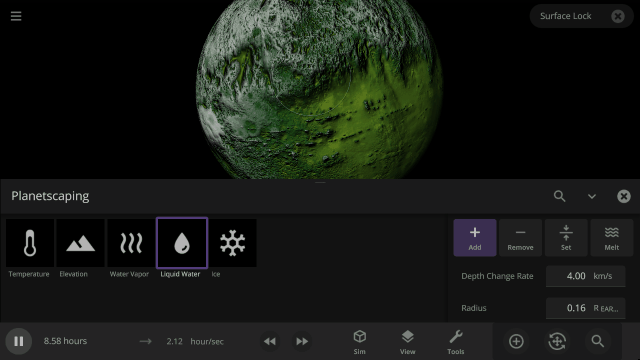
In 2022, we put out 9 updates for Universe Sandbox. These included many new features, but some of our favorites are
- Spinning up planets so fast they break apart using the new Force Spin tool
- Exploring constellations for 10 different cultures
- Customizing the look and topography of planets and moons with a library of realistic color and height maps
- Fundamental improvements to our planetary collision system
Check out our 2022 Retrospective for more on what we did last year.
So What’s the Plan for 2023?
- Add more materials for constructing & simulating planets & atmospheres
- Overhaul our under-the-hood physics architecture to improve accuracy and performance
- Simulate light emission from hot planets
- Continue work on bringing Universe Sandbox to phones and tablets
- Improve our development tools to identify issues quickly and provide a more bug-free experience
Many of our projects, like bringing Universe Sandbox to phones and tablets, have been in development for months or years. While we plan to work on everything we discuss here in 2023, complications may cause features to be delayed, and our priorities may change.
More Materials & Composition Simulation
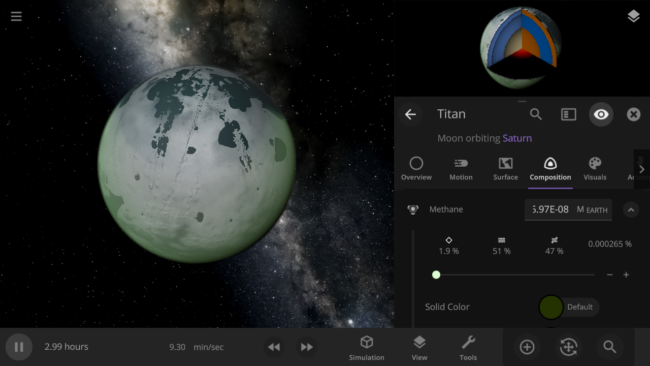
We’re expanding the number of materials in Universe Sandbox you can use to simulate, construct, and terraform planets and atmospheres realistically. For example, new materials like methane will allow us to fully simulate lakes of liquid methane on Titan. We’re also adding advanced simulation to compute planet radii based on the pressure and temperature of each material in the planet’s composition. Ever wonder how big the Moon would be if it were made entirely of oxygen? Soon you’ll be able to find out.
- A (Multi) Material World
- Planet radii and atmospheres will be realistically simulated based on the mass and phase (solid, liquid, and gas) of each material in their composition.
- Simulation of an atmosphere’s heating (the greenhouse effect), color, and opacity, including Venus-like atmospheres, will be based on their material composition.
- Designing the properties, data views, and tools for you to construct atmospheres, build and terraform planets, and track these materials is a crucial part of our development process.
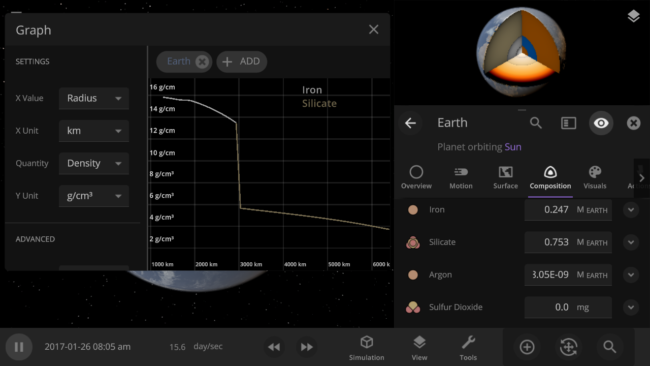
- Physics-based Phases
- The phase of each material in a planet’s composition will be realistically determined based on its pressure and temperature. Make a planet entirely out of water and see the phases from the inside out (our current model says it would be 100% liquid inside).
- Material phase models are based on geological and astrophysical measurements and research.
- Planet radii will then be calculated based on the phase and density of each material that makes up a planet’s composition. If you change the composition, the radius will change with it.
- The phase of each material in a planet’s composition will be realistically determined based on its pressure and temperature. Make a planet entirely out of water and see the phases from the inside out (our current model says it would be 100% liquid inside).
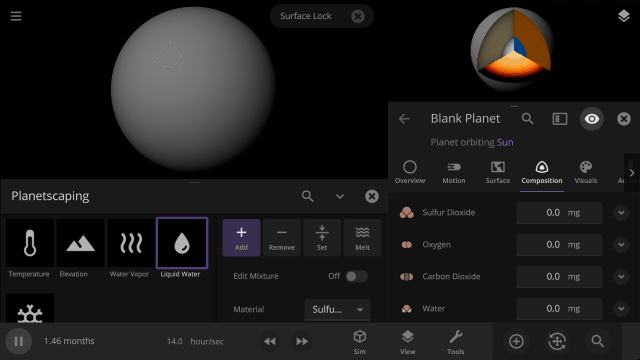
- Tracking Materials
- Materials will have customizable colors based on their physical properties that will blend on the surface of objects. Watch oceans of methane mix with oceans of oxygen in real time.
Physics Fundamentals
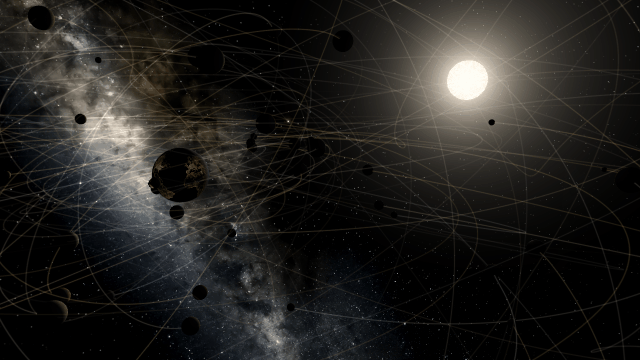
Our project to add everyday object collisions, like throwing a banana at a car, led us to first rewrite our physics architecture. Realistically smashing satellites together is part of continuous efforts to improve the realism and performance of Universe Sandbox.
- New Physics Architecture
- Overhauling our custom N-body (gravity) simulation will improve gravity-related accuracy, stability, and performance. Tight orbits like the Hubble Space Telescope around Earth should be stable at simulation speeds as high as a month per second (instead of a few days).
- These updates are the foundation for future physics improvements, like spaceships.
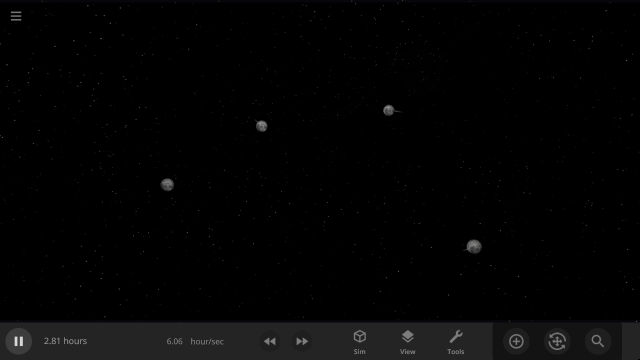
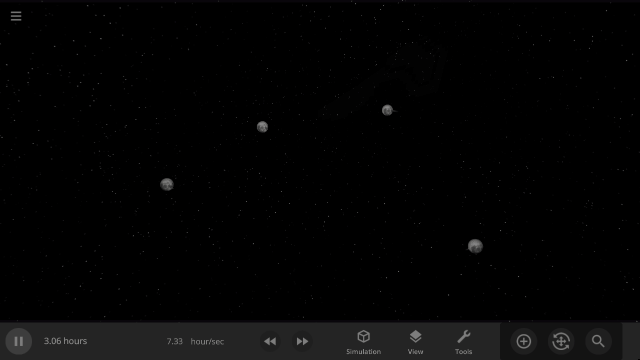
- Everyday Object Collisions
- Currently, when objects collide, they’re treated as spheres. We’re working on adding new physics so that everyday objects, simple shapes like dice and pyramids, but also complex shapes like sledgehammers and spacecraft, will collide according to their unique forms. This is often known as rigid body collision physics.
- Improved Planetary Collisions
- We’re researching methods to allow objects to stretch and deform, like two fluids mixing, during collisions, to improve upon the sphere absorbing method we currently use. Stay tuned for a status update later this year.
- Meteors & Shooting Stars
- To simulate meteors and shooting stars, we’re working on allowing objects to burn up while traveling through a planet’s atmosphere. We’re exploring ways of applying this drag force to objects passing through gas clouds and liquids too. Currently, atmospheres have no effect on objects as they pass through them.
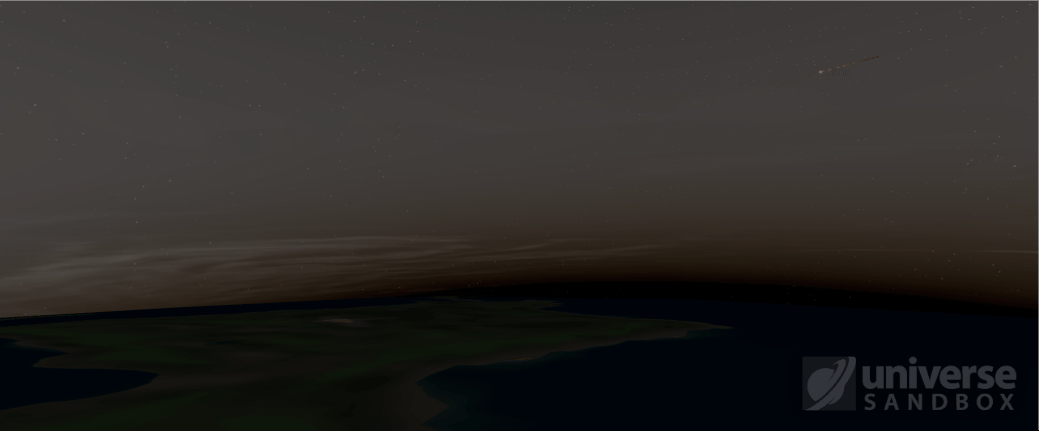
- Advanced Game Engine Features
- As an ongoing project to optimize our simulation, we’re transitioning to the Data-Oriented Technology Stack (DOTS) from Unity, the game engine we use to build Universe Sandbox. We’re excited about the expected performance gains.
Lights in Space
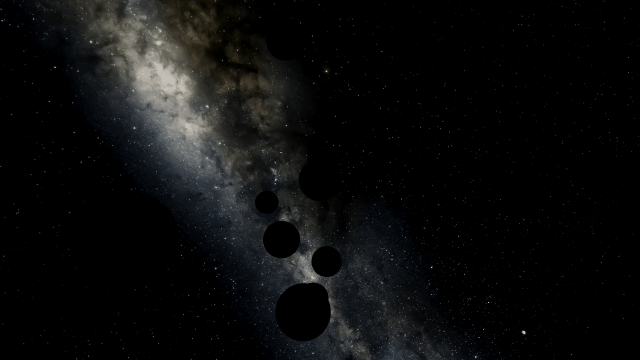
We want to light up the universe – by allowing hot planets and moons to emit light. We’re also planning a massive graphics overhaul that will change how you see the Universe (Sandbox).
- Light ‘em Up
- Light – it’s not just for stars anymore. Hot planets will emit light based on their temperature so you can light up your simulation by setting Earth to 1000 °C.
- This lighting system will eventually allow you to place and customize lights anywhere in the simulation so you can illuminate your universe without stars.
- Untitled Graphics Overhaul
- We don’t want to say too much yet, but we’re working on a massive update to our graphics system that the whole team is very excited about.
Universe Sandbox on Tablets & Phones
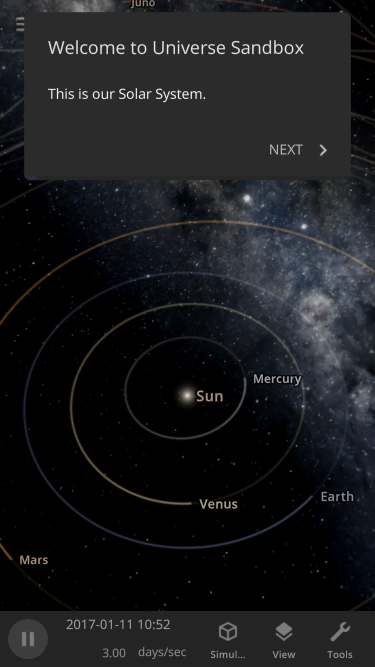
We’re stepping up our development for Universe Sandbox on mobile devices (for iOS and Android) after some delays last year. You can read about our plans in our first Mobile DevLog, and be on the lookout for more updates in the future.
- Small Screen Experience
- The primary obstacle in mobile development is adapting our interface that works well on a large screen to work on a small touch screen (like a phone).
- We’re building a system to intelligently resize, hide, and reveal panels as needed. Our goal is to reduce the need for you to spend time managing the user interface so you can focus on bending the simulation to your will.
- All of the Above
- Universe Sandbox on mobile is built from the same codebase as the desktop version and will have the same features.
- Performance is also critical, and we’re working to make Universe Sandbox run smoothly on mobile devices no matter the simulation.
Enhancing Our Developer Toolkit
We’re creating new internal tools to make developing and releasing updates of Universe Sandbox faster. These include systems to analyze your feedback and automate testing for bugs and issues.
- Testing 1, 2, 3
- Creating tests that run automatically to check our collision physics, simulation performance, and more will help us catch issues before they’re released. These tests record data and images we can use to find bugs more easily.
- Tracking Feedback
- Your in-game feedback and issue reports help us improve Universe Sandbox, and there’s a lot to review. We’re transitioning to a new system to sort and analyze your feedback more efficiently.
- Building the Sandbox
- We’ve revamped our automated build system. This system creates a new version of Universe Sandbox in the cloud every time a change is made by one of our team members.
- This automation saves each of us 10-15 minutes each time we want to review a change.
- With a single button, we can also release new updates to all digital stores that sell Universe Sandbox. This process used to take many hours and involved dozens of manual steps, so this makes it possible to release more updates faster.
- This new system easily makes versions of Universe Sandbox we can test on phones and tablets (iOS and Android) too.
- We’ve revamped our automated build system. This system creates a new version of Universe Sandbox in the cloud every time a change is made by one of our team members.
- New Trailer
- We’re producing a new Universe Sandbox trailer fabricated entirely in-game. We’ll be able to capture it with a single button press, making it easier to iterate on the trailer over time to show off the latest features and improvements.
- You will be able to play this new trailer inside Universe Sandbox, breaking out of it to experiment or explore every shot and simulation.
And Beyond

We’re always thinking about the future of Universe Sandbox. Our longer-term goals include gamepad support, life simulation, and more planet customization options. These are still in early development, and we don’t have a timeline for their release (because software development is hard, and not even our astrophysicists can predict all of the complexities of simulating the universe).
- Custom Textures
- We want to give you more control over the appearance of your planet. Satisfy your world-building desires by creating a planet using custom maps or images, like a picture of your dog.
- Gamepad Support
- What could be better than playing Universe Sandbox from the comfort of your couch? We’re working on adding gamepad support for more ways to control your universe. This will improve our Steam Deck support and has the potential to support other gamepad-based systems in the future.
- Life Simulation
- Our expanded materials improvement is the cornerstone of our plans for life simulation. Once Universe Sandbox includes the essentials for life, like oxygen and carbon dioxide, we will be able to explore simulating simple life that will spread across the surface of a planet.
We’re excited for the year ahead and can’t wait to make Universe Sandbox even better!

A Comet, an Asteroid, and a Planet Walk into the Solar System | Update 32.2
Mar 23rd
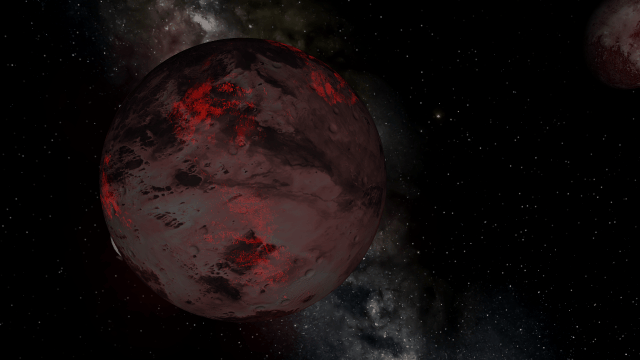
If Update 32.2 does not download automatically, follow these update instructions. If you don’t own Universe Sandbox, you can buy it via our website.
Watch a green comet pass by Earth for the first time in 50,000 years, see an asteroid swing by Earth in one of the closest ever encounters, and explore a hypothetical planet from the 1800s disproven by Einstein’s theory of relativity. Speaking of comets, asteroids, and planets…
A comet, an asteroid, and a hypothetical planet walk into the Solar System. The hypothetical planet says to the comet, “Why so green?” The comet says, “It’s the radiation from the Sun evaporating the carbon on my surface. You’d know that if you were as close to the Sun as people thought you were.” The hypothetical planet turns red with anger and ceases to exist. The asteroid says, “Phew, that was a close one!”
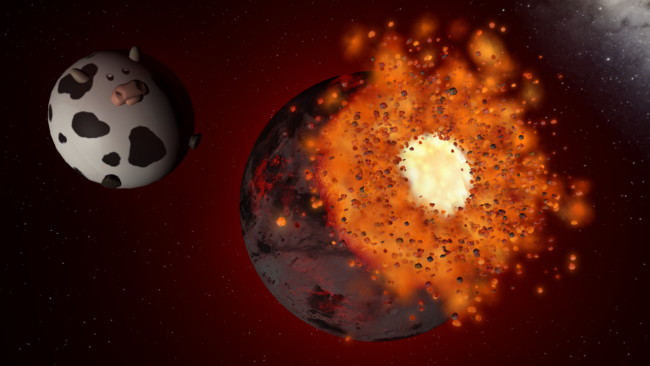
A Green Comet
The green comet, C/2022 E3 (ZTF), recently passed by the Earth for the first time in 50,000 years. Explore its path and watch this once-in-a-lifetime event occur over and over with our new simulation
The Green Comet C/2022 E3 (ZTF) in 2023
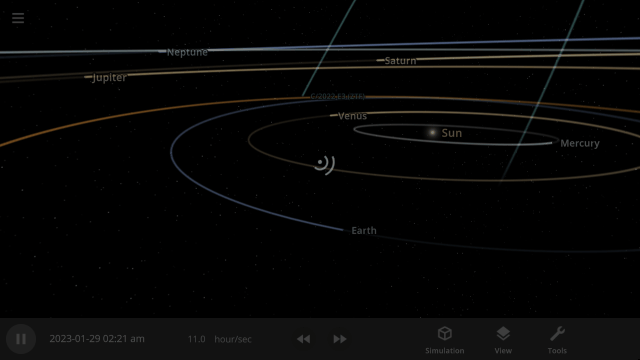
Close Encounters of the Asteroid Kind
Asteroid 2023 BU performed a close pass of Earth (though it posed no threat), only 2,200 km from the surface. That’s just under half the length of the United States! Watch one of the closest asteroid encounters ever recorded in our new simulation
Asteroid 2023 BU Close Encounter in 2023
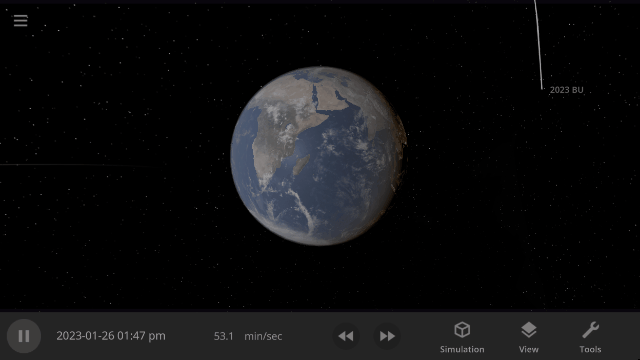
The Non-Existent Planet
In the 1800s, many astronomers thought there was a planet, dubbed Vulcan, between Mercury and the Sun. Mercury’s orbit was observed to wobble slightly more than predicted, and Vulcan was hypothesized to explain this. We now know Vulcan does not exist, and general relativity causes the additional wobble, but you can see Vulcan’s proposed orbit in the new simulation
Hypothetical Planet Vulcan

More Highlights
Landing (press “c”) on the surface of a planet now always points you toward the horizon. Taking off returns you to your previous position instead of in front of the planet.

On February 3, 2023, astronomers announced the discovery of 12 more moons orbiting Jupiter. Learn about these new moons in our new simulation
Jupiter’s New Moons 2023
Or explore the history of the discovery of all of Jupiter’s 92 moons in our guide
History of Jupiter’s Moons
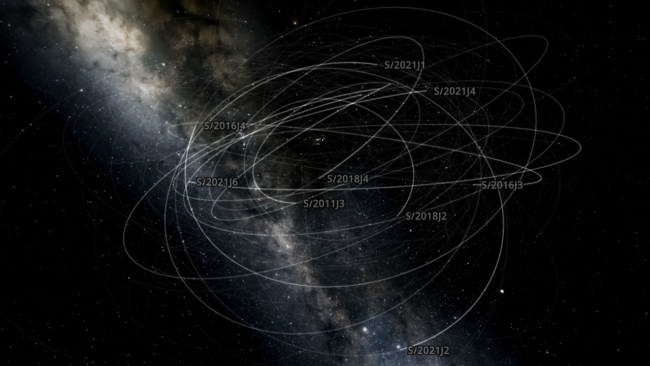
We added a Spherical Cow to Universe Sandbox! This refers to a joke that when physicists want to make a problem easier to handle, they sometimes simplify it so much it’s no longer realistic.
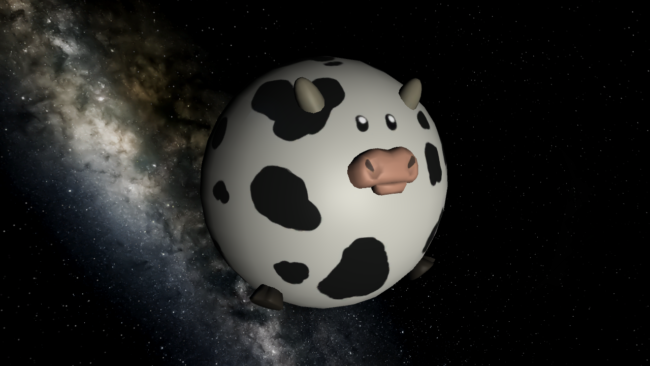
Experience 100 spherical cows hitting Earth at lightspeed in our new sim
Earth & 100 Spherical Cows at the Speed of Light
Because why not?
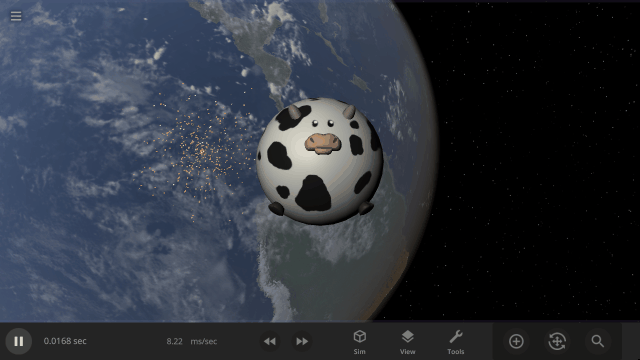
Check out the full list of What’s New in Update 32.2
Please report any issues on our Steam forum, on Discord, or in-game via Home > Send Feedback.

Universe Sandbox 2022 Retrospective
Mar 2nd
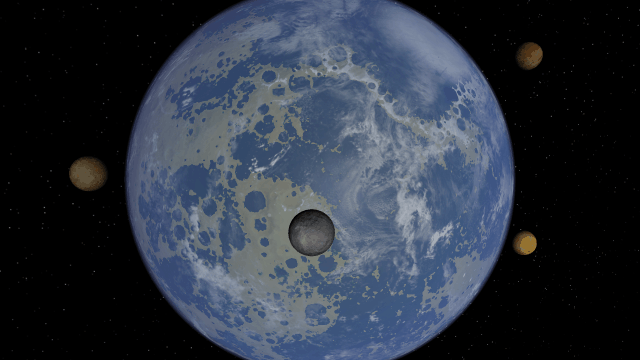
We’re excited about our plans for 2023, including adding more materials to planets as well as improvements for our physics simulation, but we’ll dive into our roadmap in an upcoming post. First, let’s reflect on some of our accomplishments from 2022.
1
New team member
Last year, Conrad joined the team as our User Interface Engineer. Since then, Conrad has been adding interface controls for object customization, fixing general usability issues, and helping to make our user interface easy to use on small screens in preparation for Universe Sandbox on mobile.
8
New guides and fly-by simulations added to Universe Sandbox in 2022
We added new guides on object customization and a simulation of NASA’s DART mission. This ambitious mission tested humanity’s ability to deflect asteroids away from Earth by intentionally crashing a satellite into an asteroid and accurately predicting the change in the asteroid’s orbital period.
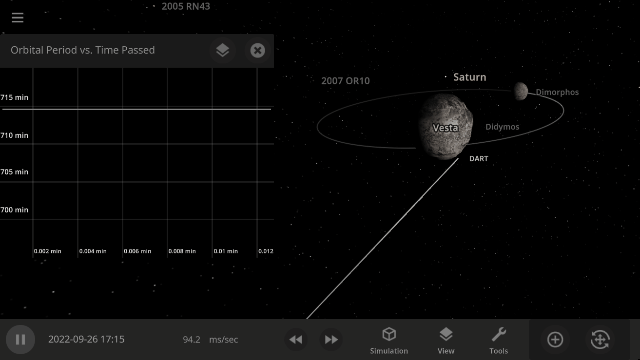
9
Significant updates to Universe Sandbox
- Consistent Collisions, James Webb, & Planetscaping Tweaks | Update 29.1
- JWST is now in Universe Sandbox, and there’s an eyedropper for the Planetscaping tool
- Hit Hard, Spin Fast | Update 30
- The new Force Spin tool allows you to spin apart planets with the newly implemented centrifugal force
- Collisions between spinning and equal-size objects are more realistic than ever before
- The habitable zone is now simulated using the selected planet’s properties, and the Hubble Space Telescope is now in Universe Sandbox
- Constellations | Update 31
- Explore constellations for 10 different cultures
- Object glows now correspond to how hot an object is
- A Warmer Welcome | Update 31.1
- Our welcome guides have been overhauled so you can discover the infinite power to create and destroy in Universe Sandbox
- Upgrading Our Engine | Update 31.2
- We updated Unity, the game engine we use to create Universe Sandbox, to allow us to utilize new features for future improvements
- Instantly see where water will flow on a planet with the new Settle Water button
- Planetary Defense DART | Update 31.3
- Many collision improvements and a simulation of NASA’s DART mission, which intentionally collided the DART spacecraft with the asteroid Dimorphos, changing its orbit & testing humanity’s ability to protect Earth from future asteroids
- Space is Big | Update 31.4
- Units of measurement have been updated to help you better understand the vastness of space
- Build-A-Planet | Update 32
- Customize and manipulate the appearance and elevation of planets using any of the in-game visual and elevation maps
- Skies of Blue, Red Collisions Too | Update 32.1
- Collision shockwaves are now more realistic, and we added basic Rayleigh scattering to atmospheres
- The simulation speed can automatically adjust itself based on various conditions, like nearby objects and collisions, by turning on Automatic Simulation Speed
View our “What’s New” for a chronological list of changes.
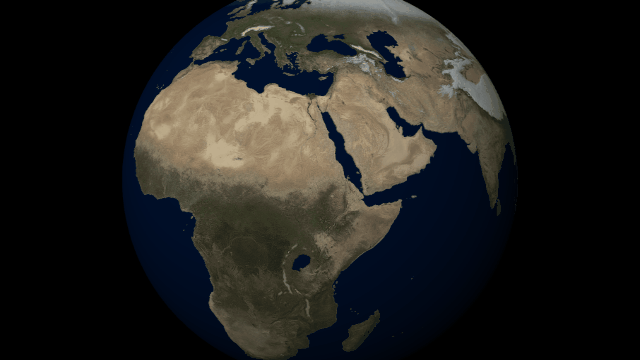
31
Preview versions uploaded in 2022
Your playtesting of our preview versions (previously called community test builds) gives us valuable feedback for improving features in active development. A huge thanks to our wonderful community for all their help.
571
Highest number of concurrent users in Universe Sandbox in 2022
The highest number of concurrent users we’ve ever had was almost in 2022: 648 on December 24, 2021. We’ve already beaten the highest number this year, but you’ll need to wait for the next retrospective to see it.
1,801
Positive Steam reviews in 2022
We’re truly humbled that we are still rated “Overwhelmingly Positive,” both recent and all-time on Steam (over 96% of reviews are positive). Your support and feedback are truly appreciated and help make Universe Sandbox even better.
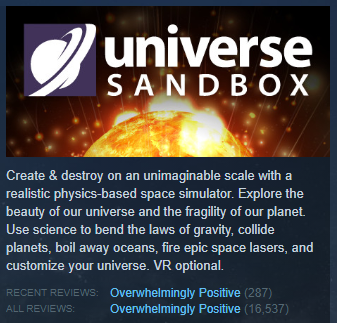
1,862
Code commits, or changes, made to the Universe Sandbox project in 2022
The most code commits occurred during the week of May 8, when 65 commits were made. While a single commit can be as small as fixing a typo, some of them have been whole new features.

7,735
Files uploaded on our team messaging app
These are files we share with each other via Slack and include screenshots and videos of features in progress, log files for resolving issues, and astronomy jokes.
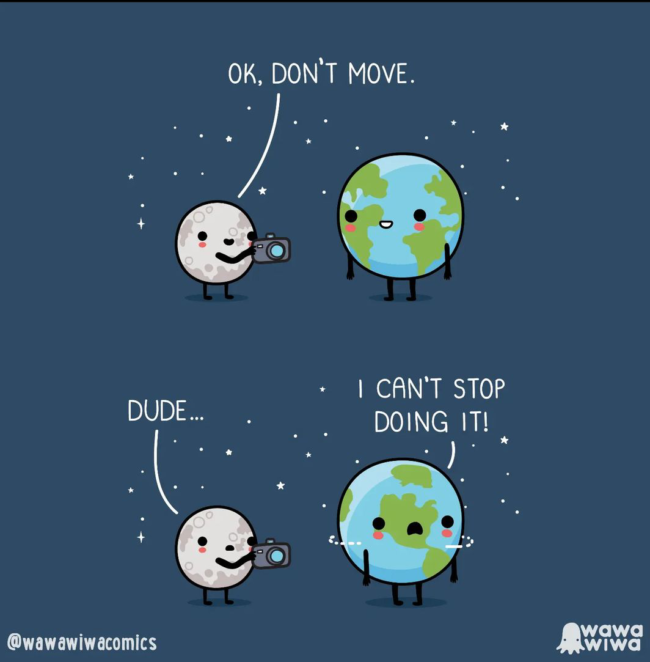
8,151
Discord users on our server at the end of 2022
It’s great to see your creations and constructive discussion on our server, which has grown by over 22.5% in the last year. Join us on Discord.
9,253
Simulations shared in the Universe Sandbox Steam Workshop in 2022
That’s more than 25 simulations shared every single day! You all continue to use Universe Sandbox in ways we could never have imagined, and we can’t wait to see what you make next.
74,257
Messages sent on our team messaging app
Giant Army has been entirely remote since its founding in 2011, and with 13 team members across 3 continents and 6 time zones, messaging on Slack is how we get most of our work done.
537,209
Times the Welcome to Universe Sandbox guide was played
Whether you’re a new player or just wanted to check out the reimagined welcome guides we released last year, we hope you enjoyed learning about the beauty of our universe. You’re using that knowledge responsibly, right?
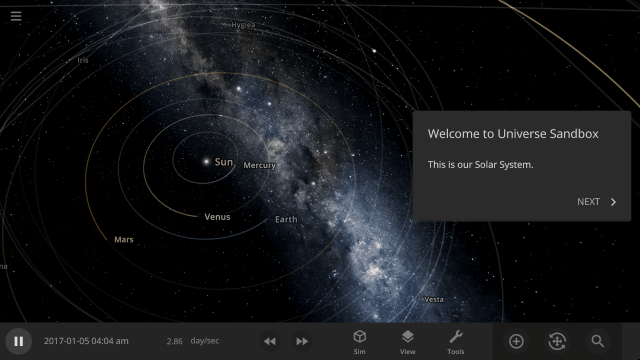
911,241
Times the Planetscaping tool was used in 2022
Letting you shape and customize planets is integral to the spirit of Universe Sandbox, and we’re glad you’re experimenting with the power that comes with it.
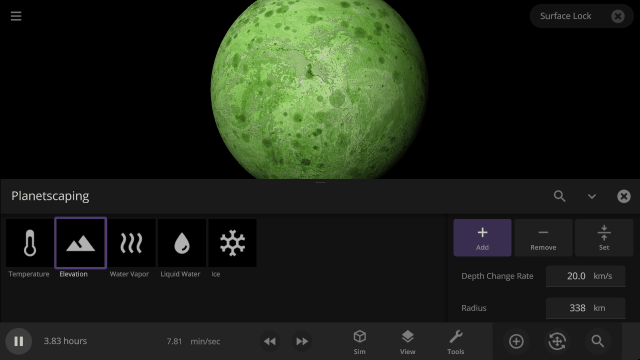
1,251,635
Times supernovas went off in Universe Sandbox in 2022
Astronomers estimate there will be 1 supernova in the Milky Way every 100 years. They also think there are about 100 billion galaxies in the universe. Assuming all galaxies have a similar number of supernovas to ours, there are about a billion supernovas in the universe each year. We got about 0.1%* of the way there in 2022. Let’s see if we can get closer in 2023!
*Thanks to Steam user Nantes for pointing out that the original value of 1% was wrong, and this should be 0.1%
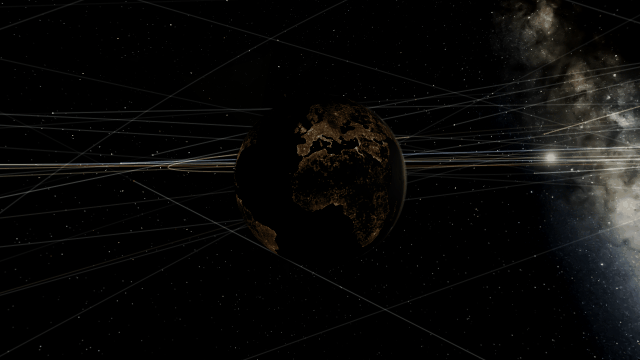
2,007,301
Times the top played simulations of 2022 were opened*
The top 10 sims of 2022 were:
| Rank | Simulation Name | Times Opened |
| 10 | Saturn with Rings | 129,522 |
| 9 | Voyager 1 & Jupiter in 1979 | 130,275 |
| 8 | Solar System – Just Planets | 136,798 |
| 7 | Milky Way & Andromeda Galaxy Collision | 145,261 |
| 6 | Earth & 100 Colliding Moons | 171,990 |
| 5 | Earth & Moon | 173,774 |
| 4 | Tidally Locked Earth | 177,224 |
| 3 | Milky Way | 189,958 |
| 2 | Galaxy Collision Hi-res | 227,148 |
| 1 | Solar System – Live View – Planets, Moons, Spacecraft | 525,351 |
*not including creating a new simulation or the Solar System simulation that opens when you start Universe Sandbox
Check them out to see what all the fuss is about!
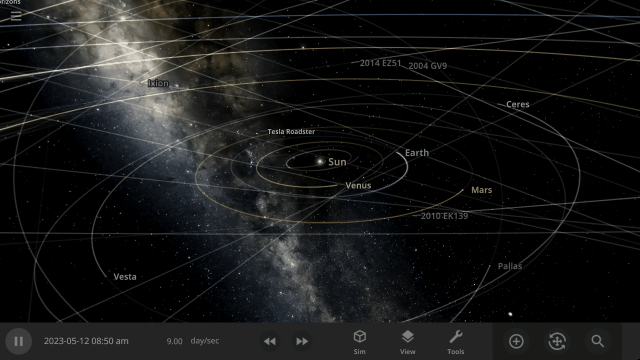
3,987,005
Times the Force tool was used in 2022
Whether you were giving planets a gentle nudge, slightly adjusting their rotation, or spinning them apart, we know you were forceful in your efforts.
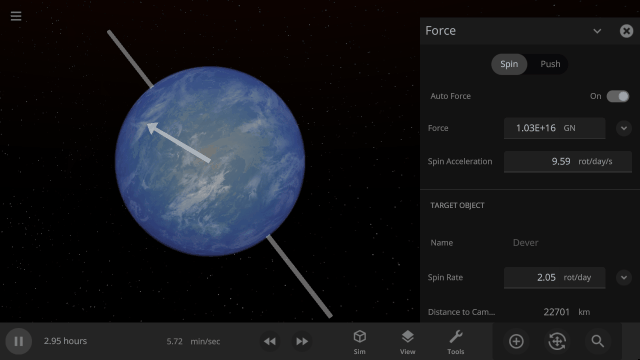
6,265,426
New simulations were created in Universe Sandbox in 2022
That’s about the same number as last year, with a new simulation created every 5 seconds.
35,802,793
Times a simulation was played or paused in 2022
By far the most popular thing to do in Universe Sandbox in 2022 was to play or pause a simulation. That’s about once every second.
What’s Next?
More materials for building planets and their atmospheres, physics simulation performance improvements, non-star objects emitting light based on their temperature, and more are in store for 2023. Be on the lookout for our 2023 Roadmap, which will have more details about our plans for this year.
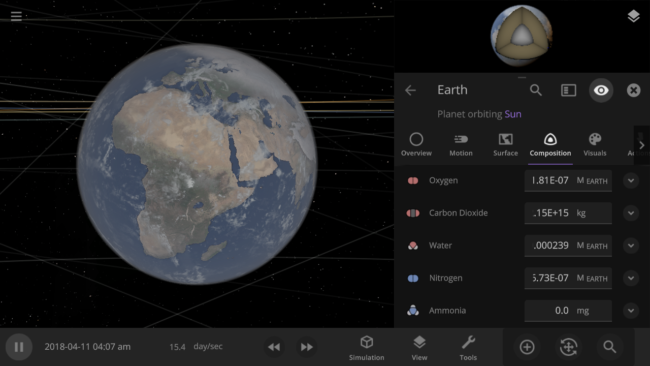
And Most Importantly…
Thank you. Your continued encouragement and support let us keep simulating the universe more realistically year after year. We are so grateful for your suggestions, feedback, and kind words. The simulations you create continue to impress us, and we want to continue improving Universe Sandbox to expand your creative (and destructive) capabilities. There’s so much to do, and we can’t wait to do it!
The Universe Sandbox Team
Dan, Chris, Georg, Jonathan, Rappo, Mat, Jacob, Erika, Brendan, Anders, Brent, Pavel, and Conrad
